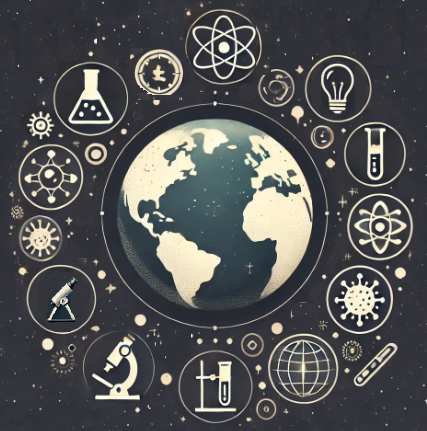Integrating Earth Science

AGI produces lessons, activities, and curricula for K-12 and informal earth science educators. However, we recognize that in many schools, earth science is taught as part of an integrated science course. The table below can help make connections between earth science concepts and biology, chemistry, and physics.
Connections to the Earth Science Disciplinary Core Ideas (DCIs)
| Earth Science DCIs | Biology Connections | Chemistry Connections | Physics Connections |
|---|---|---|---|
| ESS1.A: The Universe and Its Stars | Origins of elements necessary for life | Nuclear Reactions | Nuclear fusion; gravitational forces; electromagnetic radiation |
| ESS1.B: Earth and the Solar System | The location of Earth is ideal for supporting life | Compare molecules on Earth with those on other celestial bodies | Planetary motion |
| ESS1.C: The History of Planet Earth | Geological and climatic changes affect evolution | Chemical composition of rocks, sediments, and atmospheric gases over Earth's history provides insights into past climates | Radioactive decay for dating rocks; seismic wave propagation for understanding Earth's interior |
| ESS2.A: Earth Materials and Systems | Soil's role in ecosytems; mineral requirements; organisms’ role in matter and energy cycles | Chemical composition as it relates to weathering and mineral formation | Density, elasticity, and thermal conductivity of rocks and minerals |
| ESS2.B: Plate Tectonics and Large-Scale System Interactions | Distribution of continents impacts migration and evolution | Plate tectonics, volcanic activity and metamorphic processes involve unique chemical reactions | Physical forces such as plate movement, stress, and strain; energy transfer, convections currents within mantle |
| ESS2.C: The Roles of Water in Earth’s Surface Processes | Nutrient transport; climate regulation; aquatic ecosystems | Water’s involvement in chemical interactions with minerals and organic matter | Fluid dynamics; hydrostatic pressure; wave mechanic |
| ESS2.D: Weather and Climate | Determine where ecosystems form; changes affect species distributions and the timing of biological events | Influenced by the chemical composition of the atmosphere | Influenced by physical principles such as thermodynamics, fluid dynamics, and radiation |
| ESS2.E: Biogeology | Interaction of living organisms and geological processes; soils; erosion | Organisms affect the chemical composition of soils, sediments, and rocks | Energy transfer with and between the biosphere and geosphere |
| ESS3.A: Natural Resources | Availability and management impact ecosystems and biodiversity; depletion can lead to ecological imbalances | Chemical properties and processes related to minerals, fossil fuels, and water | Energy transformations; physical impacts of resource extraction on the environment |
| ESS3.B: Natural Hazards | Impacts on ecosystems and species survival | Involve chemical processes like the release of gases and the formation of new minerals | Studied through physical principles like seismic wave propagation, fluid dynamics, and wave mechanics |
| ESS3.C: Human Impacts on Earth Systems | Deforestation/ habitat destruction; invasive species; effects of pollution on biodiversity; conservation, sustainable management | Chemical makeup of pollution; combustion of fossil fuels | Principles related to energy use, pollution, and environmental changes |
| ESS3.D: Global Climate Change | Shifting habitats, altering migration patterns, and impacting food sources | Chemical composition of the atmosphere, particularly greenhouse gases like carbon dioxide and methane | Solar radiation; energy exchange and fluxes |
Click here to download a pdf of this resource.
